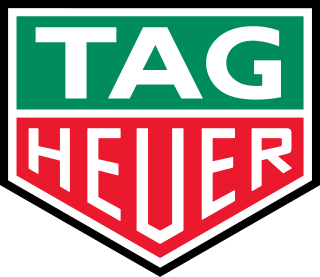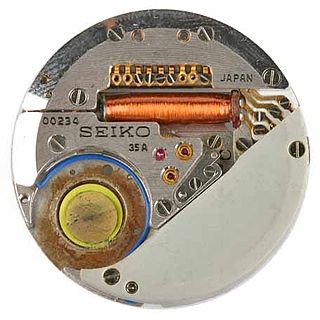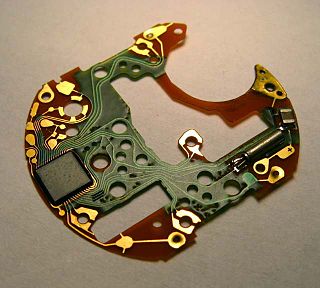
A watch is a portable timepiece intended to be carried or worn by a person. It is designed to keep a consistent movement despite the motions caused by the person's activities. A wristwatch is designed to be worn around the wrist, attached by a watch strap or other type of bracelet, including metal bands, leather straps, or any other kind of bracelet. A pocket watch is designed for a person to carry in a pocket, often attached to a chain.

An escapement is a mechanical linkage in mechanical watches and clocks that gives impulses to the timekeeping element and periodically releases the gear train to move forward, advancing the clock's hands. The impulse action transfers energy to the clock's timekeeping element to replace the energy lost to friction during its cycle and keep the timekeeper oscillating. The escapement is driven by force from a coiled spring or a suspended weight, transmitted through the timepiece's gear train. Each swing of the pendulum or balance wheel releases a tooth of the escapement's escape wheel, allowing the clock's gear train to advance or "escape" by a fixed amount. This regular periodic advancement moves the clock's hands forward at a steady rate. At the same time, the tooth gives the timekeeping element a push, before another tooth catches on the escapement's pallet, returning the escapement to its "locked" state. The sudden stopping of the escapement's tooth is what generates the characteristic "ticking" sound heard in operating mechanical clocks and watches.

A pocket watch is a watch that is made to be carried in a pocket, as opposed to a wristwatch, which is strapped to the wrist.

Seiko Group Corporation, commonly known as Seiko, is a Japanese maker of watches, clocks, electronic devices, semiconductors, jewelry, and optical products. Founded in 1881 by Kintarō Hattori in Tokyo, Seiko introduced the world's first commercial quartz wristwatch in 1969.
Bulova is an American timepiece manufacturing company that was founded in 1875 and has been owned by Japanese multinational conglomerate Citizen Watch Co. since 2008. The company makes watches, clocks and accessories, and it is based in New York City.

TAG Heuer S.A., founded Heuer AG is a Swiss luxury watchmaker. Founded in 1860 by Edouard Heuer in St-Imier, Switzerland, it was acquired by Techniques d'Avant Garde in 1985, which purchased a majority stake in the company, forming TAG Heuer. In 1999, French luxury goods conglomerate LVMH bought nearly 100 percent of the Swiss company. The name TAG Heuer combines the initials of "Techniques d'Avant Garde" and the founder's surname.

A stopwatch is a timepiece designed to measure the amount of time that elapses between its activation and deactivation.

The Contrôle officiel suisse des Chronomètres (COSC), the Official Swiss Chronometer Testing Institute, is the institute responsible for certifying the accuracy and precision of Swiss watches.

A chronograph is a specific type of watch that is used as a stopwatch combined with a display watch. A basic chronograph has hour and minute hands on the main dial to tell the time, a small seconds hand to tell that the watch is running, and a seconds hand on the main dial usually equipped with a sweeping movement for precision accompanied by a minutes sub dial for the stopwatch. Another sub dial to measure the hours of the stopwatch may also be included on a chronograph. The stopwatch can be started, stopped, and reset to zero at any time by the user by operating pushers usually placed adjacent to the crown. More complex chronographs often use additional complications and can have multiple sub-dials to measure more aspects of the stopwatch such as fractions of a second as well as other helpful things such as the moon phase and the local 24-hour time. In addition, many modern chronographs include tachymeters on the bezels for rapid calculations of speed or distance. Louis Moinet invented the chronograph in 1816 for use in tracking astronomical objects. Chronographs soon found a widespread use in artillery fire in the mid to late 1800s. Over time, the chronograph found its use to be in several different fields, such as aircraft piloting, auto racing, diving and submarine maneuvering.

A balance wheel, or balance, is the timekeeping device used in mechanical watches and small clocks, analogous to the pendulum in a pendulum clock. It is a weighted wheel that rotates back and forth, being returned toward its center position by a spiral torsion spring, known as the balance spring or hairspring. It is driven by the escapement, which transforms the rotating motion of the watch gear train into impulses delivered to the balance wheel. Each swing of the wheel allows the gear train to advance a set amount, moving the hands forward. The balance wheel and hairspring together form a harmonic oscillator, which due to resonance oscillates preferentially at a certain rate, its resonant frequency or "beat", and resists oscillating at other rates. The combination of the mass of the balance wheel and the elasticity of the spring keep the time between each oscillation or "tick" very constant, accounting for its nearly universal use as the timekeeper in mechanical watches to the present. From its invention in the 14th century until tuning fork and quartz movements became available in the 1960s, virtually every portable timekeeping device used some form of balance wheel.

In horology, a complication is any feature of a timepiece beyond the display of hours, minutes and seconds. A timepiece indicating only hours, minutes and seconds is known as a simple movement. Common complications include date or day-of-the-week indicators, alarms, chronographs (stopwatches), and automatic winding mechanisms. Complications may be found in any clock, but they are most notable in mechanical watches where the small size makes them difficult to design and assemble. A typical date-display chronograph may have up to 250 parts, while a particularly complex watch may have a thousand or more parts. Watches with several complications are referred to as grandes complications.

A balance spring, or hairspring, is a spring attached to the balance wheel in mechanical timepieces. It causes the balance wheel to oscillate with a resonant frequency when the timepiece is running, which controls the speed at which the wheels of the timepiece turn, thus the rate of movement of the hands. A regulator lever is often fitted, which can be used to alter the free length of the spring and thereby adjust the rate of the timepiece.

The history of watches began in 16th-century Europe, where watches evolved from portable spring-driven clocks, which first appeared in the 15th century.

A mechanical watch is a watch that uses a clockwork mechanism to measure the passage of time, as opposed to quartz watches which function using the vibration modes of a piezoelectric quartz tuning fork, or radio watches, which are quartz watches synchronized to an atomic clock via radio waves. A mechanical watch is driven by a mainspring which must be wound either periodically by hand or via a self-winding mechanism. Its force is transmitted through a series of gears to power the balance wheel, a weighted wheel which oscillates back and forth at a constant rate. A device called an escapement releases the watch's wheels to move forward a small amount with each swing of the balance wheel, moving the watch's hands forward at a constant rate. The escapement is what makes the 'ticking' sound which is heard in an operating mechanical watch. Mechanical watches evolved in Europe in the 17th century from spring powered clocks, which appeared in the 15th century.

A marine chronometer is a precision timepiece that is carried on a ship and employed in the determination of the ship's position by celestial navigation. It is used to determine longitude by comparing Greenwich Mean Time (GMT), and the time at the current location found from observations of celestial bodies. When first developed in the 18th century, it was a major technical achievement, as accurate knowledge of the time over a long sea voyage was vital for effective navigation, lacking electronic or communications aids. The first true chronometer was the life work of one man, John Harrison, spanning 31 years of persistent experimentation and testing that revolutionized naval navigation.

The quartz crisis (Swiss) or quartz revolution was the advancement in the watchmaking industry caused by the advent of quartz watches in the 1970s and early 1980s, that largely replaced mechanical watches around the world. It caused a significant decline of the Swiss watchmaking industry, which chose to remain focused on traditional mechanical watches, while the majority of the world's watch production shifted to Japanese companies such as Seiko, Citizen and Casio which embraced the new electronic technology. The strategy employed by Swiss makers was to call this revolution a 'crisis' thereby downgrading the advancement from Japanese brands.

Quartz clocks and quartz watches are timepieces that use an electronic oscillator regulated by a quartz crystal to keep time. This crystal oscillator creates a signal with very precise frequency, so that quartz clocks and watches are at least an order of magnitude more accurate than mechanical clocks. Generally, some form of digital logic counts the cycles of this signal and provides a numerical time display, usually in units of hours, minutes, and seconds.
An observatory chronometer is a timepiece that has passed stringent testing and a slate of accuracy tests. Thus, the "observatory trial" developed as the standard process for determining accuracy of timepiece movements. If the chronometer passed the stringent testing, it would be certified.

Hoptroff is a provider of distributed timing services, based in London, England.

MB&F is a Swiss luxury watch and clock manufacturer founded by Maximilian Busser in July 2005 in Geneva, Switzerland. MB&F specializes in small series of concept-type watches. MB&F's clocks have a futuristic style, and the company has collaborated with other artists and watchmakers.




















